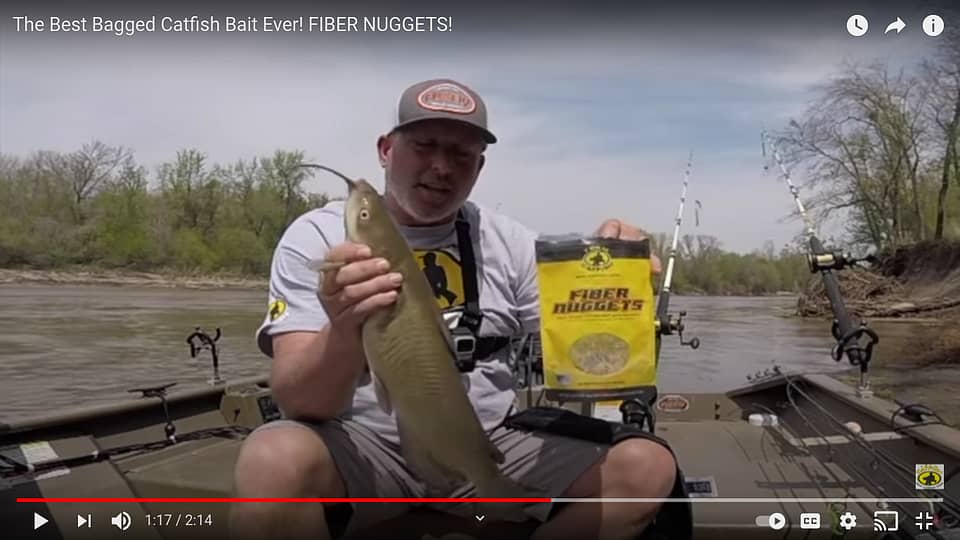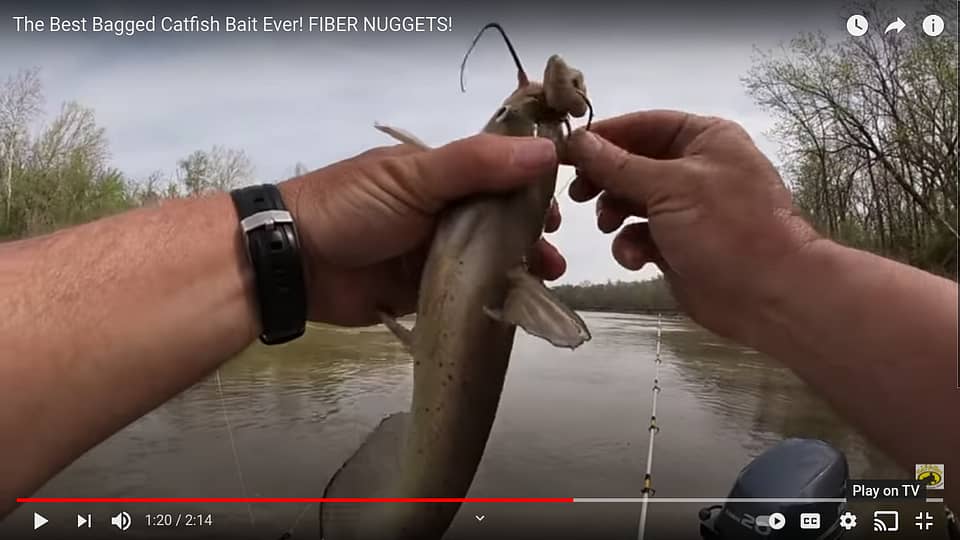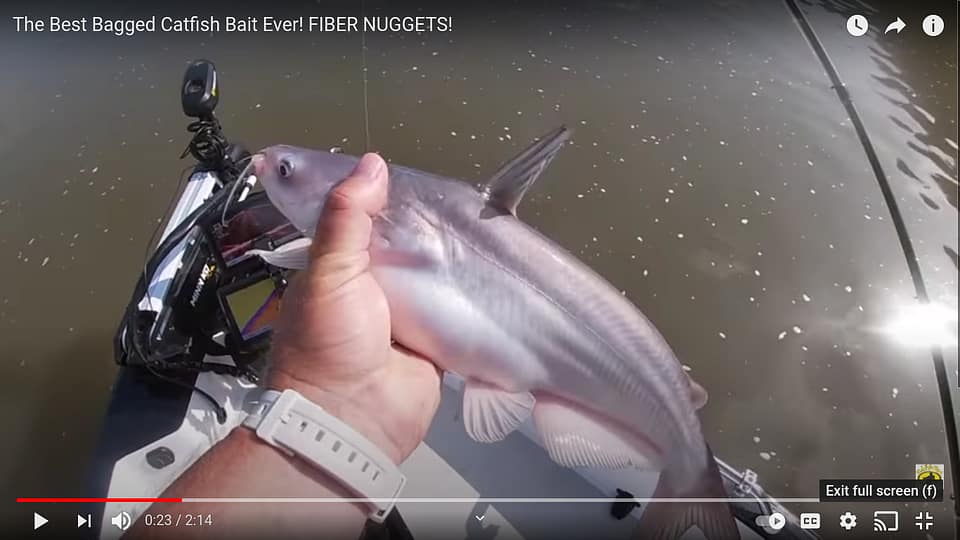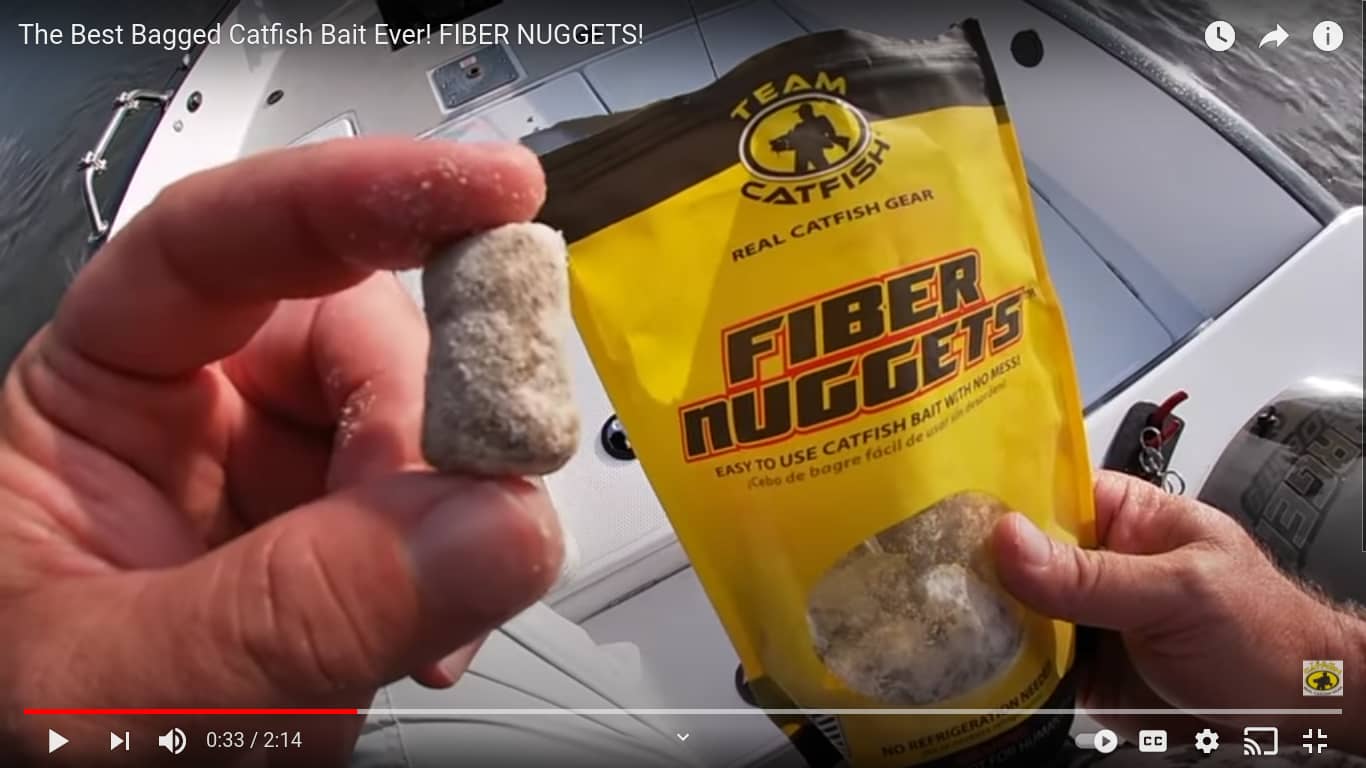143 pounds. That is, according to an article from Catfish Edge, the current world record Blue Catfish. This goliath of a catfish was caught at Buggs Island Lake in Virginia. What bait was used to catch this monster you might ask? Those who landed the record fish did not say. This brings up a current issue on the catfishing scene. The question being asked around is what bait is best for catfish. Many people have their own preferences, and many companies market their manufactured baits as being the best. One of the companies, Team Catfish, released a video describing a new bait product they created which claims, among other things, to be great for Blue and Channel Catfish. I have decided to debunk the claims present in this video, which is narrated by Team Catfish creator and owner Jeff Williams, to help provide clarity on the catfish bait topic. As well as point out misinformation coming from catfish bait companies. Most of the claims present in this video are not correct and are misleading. However, one in particular is partially true, although it is misleading until a deeper look into it is taken.
“I don’t recommend them for Flathead Catfish, but for Blue Catfish and Channel Catfish they [Fiber Nuggets] are absolutely wonderful.” (1:10-1:18)

The most important claim that Williams makes in the video is that Fiber Nuggets, Team Catfish’s new product, work great for Blue and Channel Catfish. Flathead Catfish are left out of this advertisement, and will be left out of this post, since, generally, Channel Catfish and Blue Catfish are more receptive to the ingredients and methods that manufactured catfish baits undertake. Manufactured catfish baits are also generally tailored towards Blue and Channel Cats over Flatheads. At this point in the video the background footage shows Williams using Fiber Nuggets to catch a frisky Channel Cat. The implied meaning behind that Fiber Nuggets work great for Blue and Channel Cats is that they will catch a lot of fish and can help catch big fish. This means that Blue Cats and Channel Cats would happily and frequently eat Fiber Nuggets if given the option, even if other baits are present. However, a look into the diets of these fish says otherwise.
In an article for Sciencing, a website which aims to provide science based information to students, the normal diets of Channel Catfish are described. The article states how adult Channel Catfish typically target live prey items, but that they are also quite willing to eat decaying fish that are on the bottom of the water body. The main prey items that adult Channel Catfish pursue are fish, frogs, crayfish, and clams, although diets vary according to the seasons and what forage is available during any given season. The article also states how “[C]hannel catfish will supplement their diets with plant material,” such as various fruits or berries that happen to drop into the water in addition to their normal diet of fish. While Team Catfish does not disclose the ingredients they use in their Fiber Nuggets, and neither do most other bait companies, it is unlikely that they contain the foods that Channel Catfish would choose in the wild. Although Channel Catfish will generally eat most things they encounter, Blue Catfish tend to stick to their normal diet. Chad Ferguson, one of the most highly regarded catfishermen in the country and professional catfishing guide, wrote an article in Catfish Edge, a website that shares information regarding catfish and how to catch them which Ferguson created, pertaining to the baits he trusts when going after Blue Cats. First, Ferguson states how Blue Cats normally spend their days searching for food and that their main food source is whatever baitfish is most prevalent in whatever water Blue Cats inhabit. For most bodies of water, this will either be “threadfin shad, gizzard shad, or skipjack herring.” According to Ferguson, most Blue Cat anglers use these baits, as they consistently produce numbers and large sizes of Blue Cats in most situations. Ferguson also notes that the bait you will most likely have the most success with is fresh, live or dead, pieces of whatever baitfish is present in the body of water you are fishing. Due to these factors, as well as the amount of oils that a bait sends into the water, “cut baits will outperform [. . .] manufactured baits for catching blues.” As a final note, Ferguson adds how there is no magic bait that will always catch numbers of fish and big fish when it comes to fishing for Blue Cats. As Team Catfish has not released the ingredients they use in their Fiber Nuggets, although their original flavor is cheese, I feel it is safe to say that Fiber Nuggets do not release, or release less of, the oils that attract Channel and Blue Cats to a bait. Because of this, natural baits, like live or cut fish, are more readily taken by Channel and Blue Cats, disproving Williams’ implied claim that Fiber Nuggets work well for Blues and Channels, even to the point of out producing natural baits.
Bagged baits are the best and you will use them.
Throughout the video, it is implied that people will use bagged or manufactured catfish baits instead of natural ones. This is evident through how Williams fails to mention that natural baits are an option. While this video is an advertisement for Fiber Nuggets, it compares Fiber Nuggets towards other manufactured catfish baits, but it does not include a comparison to natural baits. However, a look into the extraordinary senses that catfish have seems to tilt the favor towards natural baits.
One article from Game and Fish magazine, a magazine which provides hunting and fishing information about the Midwest and is second only to In-Fisherman in producing reliable outdoors information, delves into the wonderful world of catfish senses. The two most amazing senses that catfish have are their senses of taste and smell, which are some of the best in the fish realm. In terms of their sense of taste, catfish have multitudes of taste buds packed all over their bodies, both inside and out. Of the many places that contain taste buds on catfish, a few are their mouth, whiskers, fins, sides, and even their tail. This allows catfish to detect prey items by bumping into them, instead of just eating it first. As great as the sense of taste that catfish have is, their sense of smell is even better. Dr. John Caprio, a neurophysiologist from Louisiana State University who has studied the senses of taste and smell in fish since 1971, provides insight into just how great a catfish’s sense of smell is. For the aforementioned article in Game and Fish magazine, Caprio describes how some species of catfish can “smell some compounds at one part to 10 billion parts of water.” This highly developed sense of smell derives from folds that are in the nostrils of the catfish. For comparison to other species, Channel Catfish have over 140 of these folds while Rainbow Trout have 18 and Largemouth Bass have only between 8 and 13. Now,most angler believe that in order to catch a catfish, the bait that is used must be the most foul smelling substance known to man. However, this is just not the case. Caprio goes on to further explain that the fish do not smell the horrible smells we do that come from our baits. While we are smelling chemicals that have interacted with the air, fish can only sense chemical compounds that are found in the water they live in. Due to this, the stinkiness of the bait we use does not matter, what matters is what we put in the bait. Furthermore, some substances can cause catfish to quit feeding. Things that are found in sunscreen, bug spray, and other common outdoor items can easily leave behind chemical compounds on your bait that cause catfish to leave the area. As I mentioned before, most bagged catfish baits do not list the ingredients that are put into them. However, the most common flavors of baits are cheese and blood. Since the companies do not disclose what goes into their baits, they could unintentionally put compounds in their baits that drive off catfish, instead of attracting them. Also, if they do put the correct compounds in their baits, they might not be in high enough concentrations to attract catfish when compared to the amount put into the water by natural baits. Due to this, the notion that bagged catfish baits are the best baits available is simply not true.
“You all know about the little bitty catfish that always peck your bait off. Well with Fiber Nuggets, you can actually hook those little bitty catfish.” (1:20-1:30)

The next claim made by Williams is that Fiber Nuggets will help you catch the smaller catfish that cannot fit other baits into their mouths. Williams attempts to back up this assertment by showing video of himself catching a ‘bait stealer’ size catfish on a Fiber Nugget. The reality of the situation is that bait size alone does not determine the size of fish that you catch. While bait size does impact the size of fish you catch, since smaller fish may not be able to hold your bait and your hook in their mouth at the same time, the most important factor in what size of fish you catch is the size of hook you use. In one of their posts aiming to teach people how to fish, TakeMeFishing,org, an organization that aims to bring people to the sport of fishing and instruct them on how to fish properly while catching fish and having fun, describes the importance of choosing the correct hook size. Early on in the post, the importance of choosing a hook that is not too big is established, as smaller fish will not be able to get hooked on a larger hook, causing them to strip your bait off the hook. Meanwhile, the opposite is true if your hook is too small. A hook that is too small could cause a larger fish to swallow it, leading to them being hooked in the stomach. Hooking a fish this deep causes excess trauma to the fish and greatly decreases your chances of successfully releasing the fish after you catch it. Because of these factors, choosing the correct hook size is more important than choosing the correct bait size. This means that Fiber Nuggets alone will not help you catch small catfish, if you do not choose the proper hook.
“The Team Catfish Fiber Nuggets are going to absolutely revolutionize the bagged catfish bait industry.” (0:29-0:37)
Another claim that Williams makes early on in the advertisement is that Fiber Nuggets will forever change the catfish bait industry. Williams claims that the design of Fiber Nuggets is wholly different than any other bagged catfish bait that is being produced by any other company. At this time, Williams can be seen showing viewers what a Fiber Nugget looks like. But the truth is, although some aspects of the design of Fiber Nuggets are new to the bagged catfish bait industry, their overall concept is the same as other products. A quick look at the product pages of various bagged catfish baits from Team Catfish and their competitor, Berkeley, reveals the similarities between the two.
On their product page for Fiber Nuggets, Team Catfish describes how to use their bait and how their bait works. The company states how you can use their bait with any hook, including J hooks, circle hooks, and treble hooks. The page then goes on to explain that Fiber Nuggets work by dissolving slowly while in the water. This is supposed to create a large scent trail that catfish will detect, leading them to your bait and hook. The product page also describes that Fiber Nuggets were created from ingredients that are known to catch catfish, however none of the ingredients are listed. Moving on to one of Team Catfish’s competitors, Berkeley, which is one of the biggest tackle producing companies in the US that has teams of scientists devoted to testing their products, and two of their bagged bait offerings. First up we have Berkley’s Gulp! Catfish Dough. On the page for this product Berkley describes how their dough balls have been formed to specifically be hooked on a normal hook or on any other hook that is used for catfishing. Berkeley also explains how their Catfish Dough greatly disperses scent when in the water, allowing you to “[expand] the strike zone” and catch more cats. Berkeley further states how their bait was enhanced with so-called Gulp! Flavor chunks, which supposedly are made from natural bait scents and flavors. Berkeley explains how these chunks are what spread a field of scent that allow catfish to find your bait. Another of Berkley’s catfish baits, PowerBait Catfish Bait Chunks, paints a similar story. Although Berkley has a less detailed description of their PowerBait Catfish Bait Chunks compared to their Gulp! Catfish Dough on their website, they still briefly explain the concepts behind the bait. Berkley states how this product was produced to be ready to rig, being both easy and quick to put on your hook. Berkley also describes how a team of their scientists had spent about 25 years ‘perfecting’ the scents and flavors that are found in this bait. However, this could be in reference to their PowerBait formula, which Berkley uses on all of their PowerBait products. As is evident, each of these baits works in just about the same way, by creating a cloud of scent and flavor that catfish are attracted to. In addition, each of these baits is meant to be used on all types of catfish rigs and hooks. Due to these similarities, the claim that Fiber Nuggets will revolutionize the bait industry is false, at least for how Fiber Nuggets and other baits work and are used.
“We were able to release a brand new product that’s gonna make your life so much easier when it comes to using manufactured catfish bait.” (0:20-0:28)

The final claim I am debunking is Williams’ claim that Fiber Nuggets will make your life so much easier when fishing for catfish. In the advertisement video, Williams describes how using Fiber Nuggets will make using manufactured baits easier through how they are used. Williams explains how Fiber Nuggets can be used with multiple types of hooks that are common in catfishing, including J hooks and circle hooks, while attracting cats while you wait for a bite. During the video, Williams shows viewers footage of a Blue Cat he caught using Fiber Nuggets. However, other companies’ products are meant to be used in similar ways, negating that Fiber Nuggets will make your life easier.
One article from In-Fisherman, the leading source of accurate fishing related information which has been highly regarded for decades, goes over how to use commercial catfish baits as well as how they work. The dough bait section of the article provides key information which contradicts Williams’ claim that Fiber Nuggets will make life easier. Eileen Holub, owner of Catfish Charlie’s which is a highly regarded competitor of Team Catfish and who In-Fisherman sought out for information on commercial catfish baits, states how the dough balls that her company produces are best used on normal hooks. In-Fisherman then explains how all you need to do is mold a bait of this type around the shank of your hook, making sure to leave some of the hook’s point exposed, and then you can begin fishing. Holub goes on to further describe how her company created their dough balls to be stiffer than traditional dough baits, which need to be formed into a ball around the hook, which causes them to disperse less scent in the water as a trade off for being easier to put on a hook and use. Part of this ease of use is that dough balls are stiffer than dough baits, leading them to be more resistant to current which allows dough balls to stay on a hook longer. This eases the task of the fisherman, who would not need to bait their hook as often as they would when using other types of manufactured catfish baits. In addition, dough balls generally come in a form of plastic, resealable bag which makes them easy to transport. Holub further states how, due to the above factors, her company’s “premolded dough baits meet an incredible demand.” As is evidenced above, the methods that Team Catfish recommends to be used with their Fiber Nuggets are similar to those expressed by other companies. Since this is the case, the claim that Fiber Nuggets will make your life easier through how they are used is false. This wraps up the claims I will be going over in this video.
As misinformation about all types of topics is being spread rapidly in today’s age. I felt as though I needed to bring clarity to a topic that I find important, at least it’s important to me. Because of these reasons, and because fishing for catfish is my favorite thing to do, I chose to provide some clarity on the topic of manufactured catfish baits. Hopefully this article will help you realize that the claims companies make about their baits are not all necessarily true, and that you do not have to purchase bagged or jarred baits to successfully catch catfish. I hope I have also made it clear that manufactured baits are meant to catch numbers of catfish, not large individual catfish. If you would like to catch large catfish, natural baits are the better option for the reasons I expressed in this post. While this post is not a complete breakdown of the topic of catfish bait, and it is far from it, I’m glad that I could at least provide the community with information to help them make whichever choice is best for them. The next world record catfish is waiting for someone to give it a bait it will readily eat. Will you be the one to tempt it?
Note about the author: I fish for catfish a lot, and I actually have multiple products from Team Catfish and quite like them as a company. In fact, I have even used Fiber Nuggets in the past, although I prefer natural baits and feel as though the claims that were made in the advertisement are not entirely true.





What do you think?
Show comments / Leave a comment